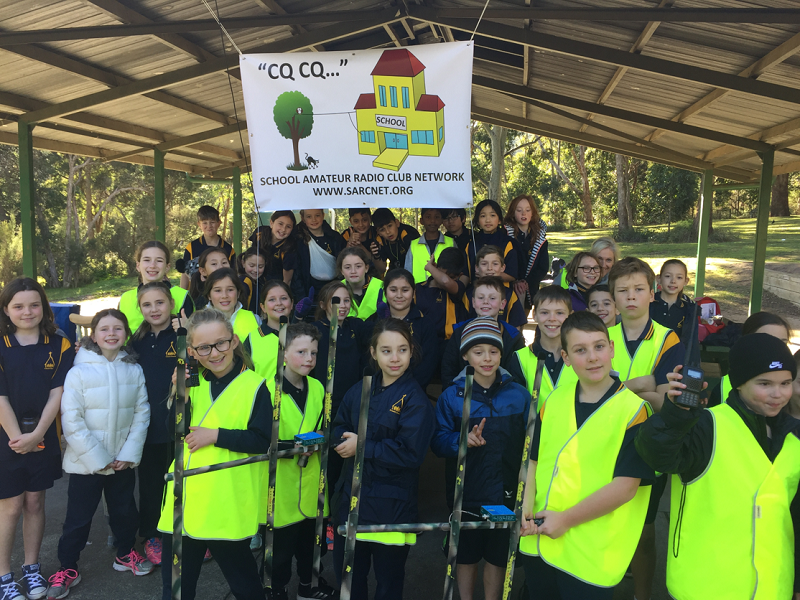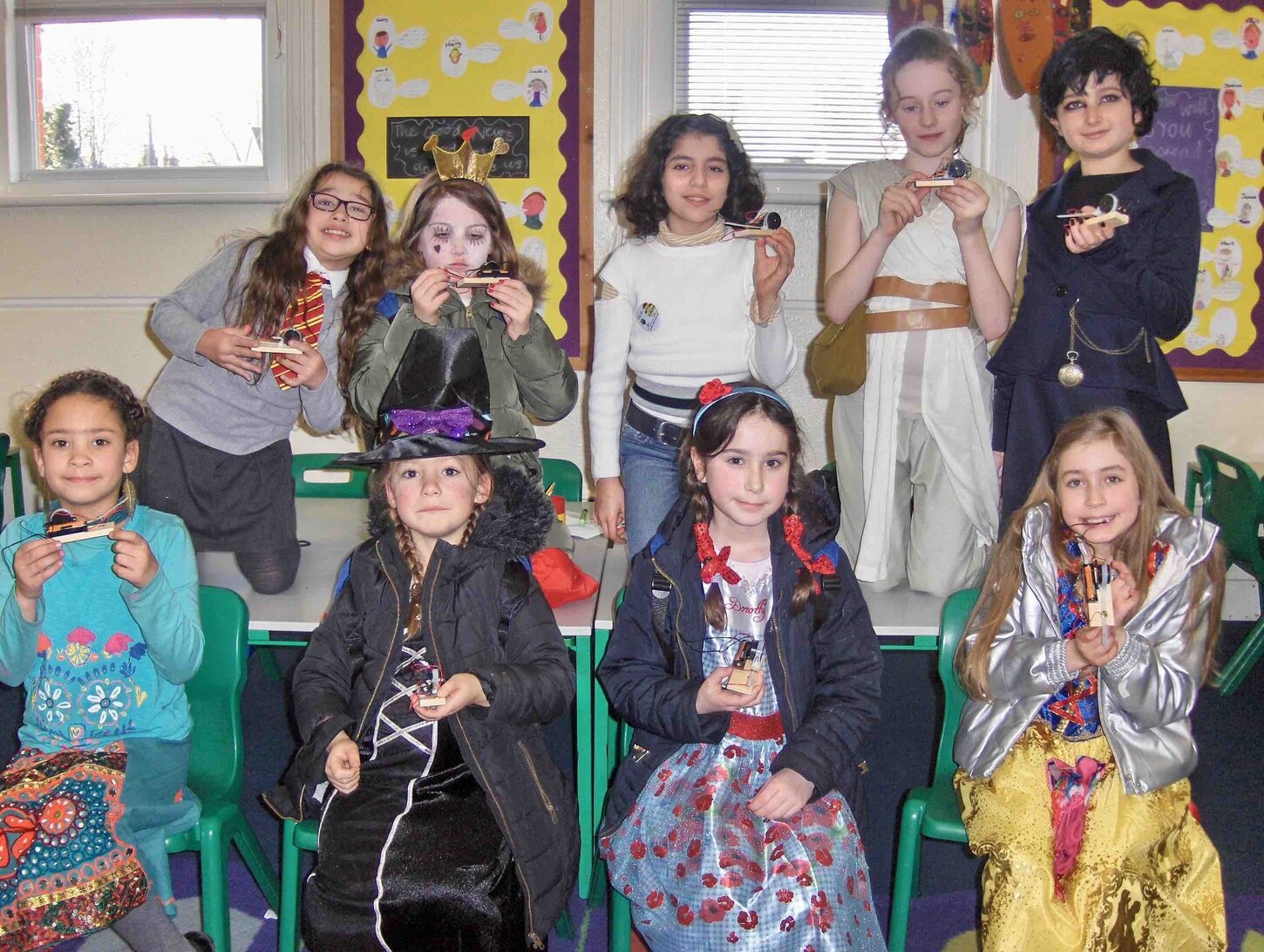Gallery
This page provides pictures of school amateur radio clubs. Please contact us to add your pictures to this page. Send us a picture and description of your SARC activity. Remember to get parental permission to publish student photographs on this site and in our newsletters.

Matt Hesse and the enthusiastic School Amateur Radio Club students at Northgate State School in Nundah in Queensland Australia. Matt is demonstrating how to set up a portable shortwave radio station using nothing more than a battery-powered radio and a wire-antenna supported by telescopic fishing poles. Matt said the kids thought the "squidpoles" were a magic trick!

Matt at Northgate State School: This time explaining how to connect the antenna to the shortwave transceiver. Matt is developing an excellent weekly program for the students. Presented as a Lesson Plan, it is well organised and thought-through. The students learn about electricity and safety; practice talking to each other using the phonetic alphabet and set up their own school Amateur Radio station. Check out Matt's Week 1 program here.

Here's the Arduino Coding Group from St. Joseph's Primary School Amateur Radio Club. It looks like they are having a lot of fun with their Arduino boards. They have entered the SARCNET Arduino Challenge and we are keen to see what amazing projects they come up with. The coordinator of the group is John Hislop G7OHO, a retired physics teacher, turned STEM Ambassador. If it wasn't for people like John, these kids would have to wait until secondary school to get into electronics. Well done John!

SARC members at St. Kevin's Primary School tracking SO-50 Amateur Radio satellite with their solar-powered, satellite communications system. The only problem for Julie is tearing them away after lunchtime to go back to class!

Year 3/4 students, including SARC members in their Hi-Vis vests, activating Churchill National Park. Activities included: HF/VHF/UHF Communications, Search and Rescue, ARDF, Bushwalking, First Aid.

Here are the STEMettes showing off their Snail Keys. These little creatures are Morse-code keys made with a buzzer, cable tie, battery and some thumb tacks on a wooden base. They only take an hour to make and you can take them anywhere.
No the girls haven't gone feral. It is book week, and they have all donned costumes and makeup of their favourite book characters. At a guess we think Freya has dressed up as “Rey” from “Star Wars - The Last Jedi” and Izzy is “Miss Peregrine” in “Miss Peregrine's Home for Peculiar Children”. How did we go, John? "Spot on" - He says. There are certainly no peculiar children in this group, John. These girls are really leading the way. We need more like them! Fantastic costumes girls!

STEMettes @ Big Bang @ Discovery Park: This free event organized by the The STEM Hub (Canterbury Christ Church University) has the aim of inspiring a love of STEM subjects - What a great idea!
So back in school uniform, here is Izzy from the STEMettes showing the boys a thing or two about Arduinos at the Science Festival. She is demonstrating the traffic lights project and it looks like the boys have nearly got the Blink sketch to work. Good job guys!
The girls chipped in to lend a hand at the stall at the Science Festival, but they also got a chance to have a look around at all the other exhibits. John reports that everyone was very impressed with their knowledge and enthusiasm. Their parents said they are still talking about it.

Back at the Big Bang stall, here is Betty and Odelyah showing the boys how to use VHF/UHF Amateur Radio Transceivers. These inspiring STEMette girls also talked about their work with the FUNcube satellite.
On the desk, they have a chart showing the Morse Code and the International Radio Alphabet and a very nice display of their Snail Morse keys.
For more information about the STEMettes please contact John G7OHO at secretary@g0hrs.org

Here we have the St. Agnes School Amateur Radio Club proudly displaying their club QSL (contact confirmation) cards with their call sign on the front: VK3SRC. When they make an on-air contact, with another Amateur Radio station, they fill out the details on the back of the cards: Date, time, band, frequency, mode, signal report, transmitter/receiver/antenna details and a message. They post the cards off to the other station and they often receive a QSL card in return. They also love using their VHF/UHF Amateur Radio handheld transceivers (pictured). These kids are having fun and learning at the same time!

We found it! Using their Yaesu FT-817 portable Amateur Radio transceiver and a directional Yagi antenna this SARC group at St. Kevin's tracked down the source of some really annoying Radio Frequency Interference (RFI)! Most people don't realize that modern technology is polluting our precious airwaves. In this case a nearby high voltage power line, with dirty insulators, is causing a loud buzzing sound coming out of the speaker on our favourite frequency, 7100kHz. It is sometimes so bad that the group has to move to another frequency up or down the band. Luckily, this noise will usually disappear after the next rainy day, when the water washes the insulators clean. Other common sources of RFI to be found around the school are AC plug packs and plasma TV screens. Recognizing the many man-made sources of noise is a first-step to understanding naturally occurring terrestrial and cosmic noise sources. Did you know that Amateur Radio enthusiasts have as many different words for RF noise as Swedish Laplanders have for snow!

Here are the STEMettes trying out the SARCNET electronics prototyping workshop in the control room of the RNLI Lifeboat Station in Margate, Kent, UK. John, who is taking the picture, reports that it requires a keen eye and some concentration to put all of the tiny electronic components in the right place. Their efforts however are rewarded with a hypnotic flashing display of two intensely blue LEDs.
Thanks to the guys for making the station available to John and these very keen students, on what seems to be perfect beach-going weather!

Here is the result: It looks like these seasoned Lifeboat crew members Rob and Steve are just as proud to have completed their working LED flasher circuit are STEMettes Izzy, Dahlia, Gracie, Caitlin and Betty.

